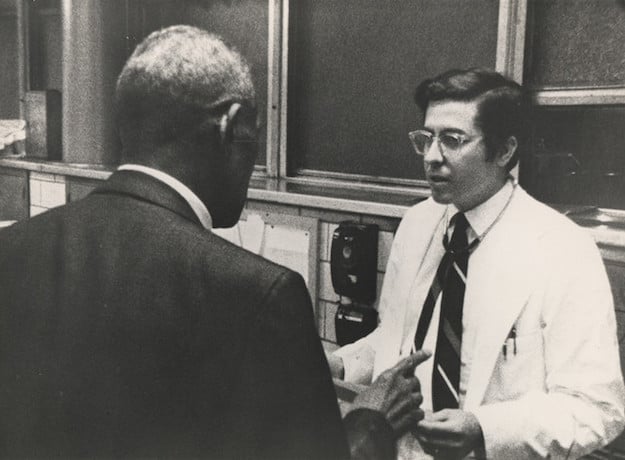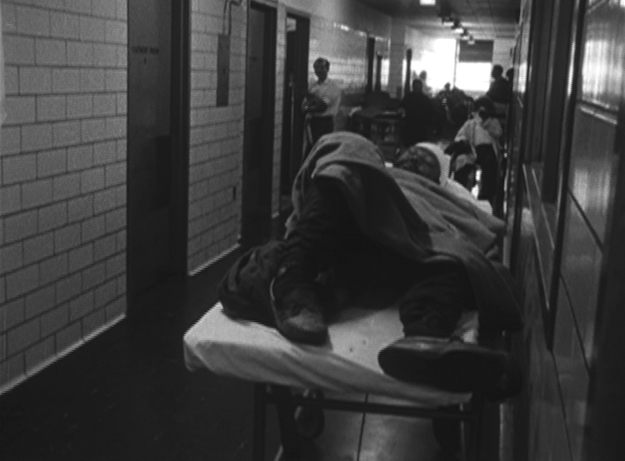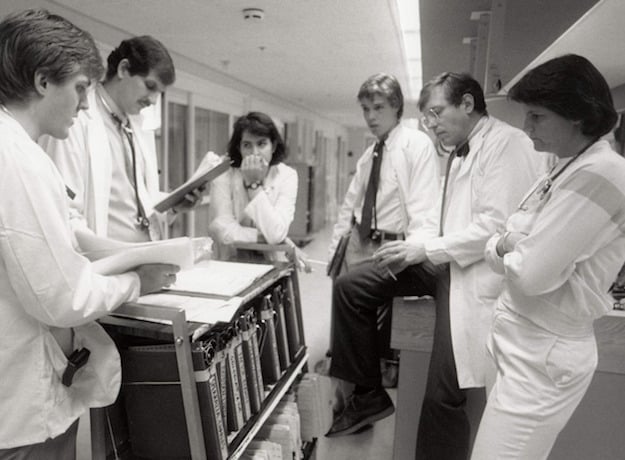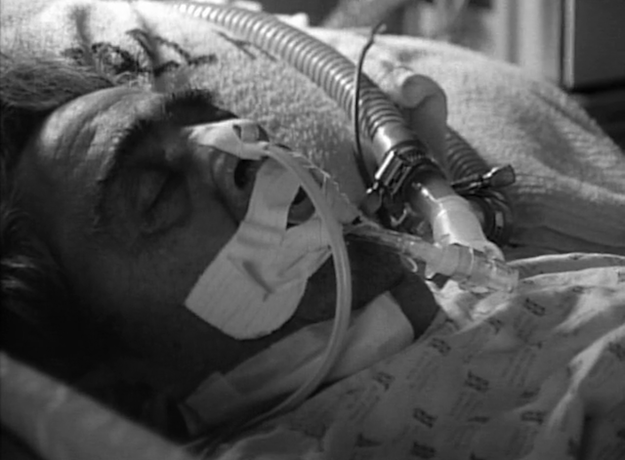Critical Care: Dr. Frederick Wiseman
“Man is not born with disease. He acquires these disorders when he tries to adapt to a certain level of civilization.” —Hospital
Hospital
As every essay about medicine must open with a pearl from William Osler, I will start with my favorite: “Remember how much you do not know. Do not pour strange medicines into your patients.”
Frederick Wiseman is, in this sense—in the best sense—an Oslerian. His films careen, cartwheel, and leap up against the very face of reality, but are always aware, on a cellular level, of quite how much they do not know. They never promise The Real Thing: an unalloyed vision of Life Itself. On the contrary, at every occasion, Wiseman hastens to remind us that he is a person, not a robot—his editing choices informed by his instinct, his moods, his rakish humor. He is a humble, elfin saint.
Before I began my own rotation at Metropolitan E.R., a friend passed me a copy of Wiseman’s Hospital (70). I watched in awe as a man on mescaline was fed ipecac, projectile regurgitating for what seemed forever. He yells, “Somebody in the park gave it to me!” He begs the staff to play calming music. It is as hilarious as it is touching—particularly when played in one’s mind over “Yakety Sax.” Wiseman gives us such moments frequently, the gravity inextricable from the levity. A solemn argument concerning child services—over a boy who fell from a window—hilariously and bathetically concludes with a nurse repeatedly asking for dinner. The boy’s ice cream drips down his face.
Hospital
Elsewhere, we watch a young gay hustler, who says he does “male prostituting—and sometimes female because I get confused.” He laughs. His situation could not be more dire—a desperate psychiatrist is seen phoning help, to prevent his winding up in an institution. But the hustler, and Wiseman, know the absurdity of it all.
Wiseman gives us fault lines, derangement, sanctity—and unknowing. In Near Death (89), the nescience is of a different sort than we find in Titicut Follies (67); its doctors are graceful, masterful, all too aware of their frailties. Dr. Taylor, a mustachioed intensivist vaguely resembling John Oates, is seen repeatedly chanting the priestly mantra: “We cannot ever predict the future.” Another ICU physician, Dr. Stein, wisely notes: “In this day and age… doctors now are extremely reluctant to say, ‘We can’t do anything for that. We have no way to help that.’” They have become the new priests.
Near Death is a tranquil, threadbare film. It says: we own this strange thing, Life, and have no way to speak of it, so we end up talking about Milrinone, blood pressure, and Christmas trees. In one of my favorite sketches in Monty Python’s The Meaning of Life, the doctors overseeing a birth demand an EEG, an “AVV,” and a machine that goes “Ping!,” all while forgetting to even bring in the patient. Confused and terrified? Amplify the Ping!
Near Death
The humor of Wiseman’s films arises from this impulse—the cockeyed, misty desire to Do Something. Humans in ludicrous fixes, dashing up the wall, the ipecac scene a prime example. Utterly disgraced, we don’t give it to anyone, practically ever. The poor man: he needed a dark room, and Brian Eno’s Music for Airports. As all of us do, at times.
Wiseman knows that there is as much honor as absurdity in the skirmish. We are awed by the infinite delicacy of Near Death’s ICU attendings, desperate to affect authority, anxious to comfort. I have tasted those Nature Valley bars. In one scene, someone whispers, “Let’s make a plan before the other doctor gets here.” Capable of the greatest love, and cloak and dagger on the order of Thunderball. Friends! Doctors are humans, too (with the notable exception, of course, of Dr. Oz).
It baffles how we could have done it back then, without CTs, cardiac stents, and oximetry. Hutber’s law: improvement means derangement. Wise, elder doctors mock us now, with our fancy equipment; we’ve forgotten the value of a good H&P. They are right. We have these magical tools, but they never bring us The Answer. My GlideScope knows I need it; he, and his nephew, the SonoSite, they mock me.
Near Death
Wiseman’s cinema is, to tempt a barbarous metaphor, an origami owl: silent, desultory, unobtrusive. It watches us. It is a mystery how he opens us up. (Wiseman’s explanation? “Vanity and indifference.”) My coworkers were once the subjects of ABC’s New York Med—and I was similarly surprised to see how little it changed people. Except the time a nurse paused compressions to ask the cameraman if her underwear was showing. (The patient lived.) The observer effect, it’s complicated.
In “Dante… Bruno. Vico… Joyce,” Beckett’s essay on Finnegan’s Wake, he contrasts Dante’s world, tidy and teleological, with the work of Joyce—earthier, messy, and purgatorial. That is Wiseman: purgatorial, and tragicomical. In one memorable scene in Near Death, a devout wife recalls laughing at a secretary on autopilot: “They called to ask if Charlie’s appointment is on; I said, he’s in the ICU. They said, ‘Does that mean he wants to cancel?’” When my grandmother was in hospice, we used to make her chuckle by sneaking in mini-bottles of whiskey. What else was there to do?
Osler’s unknowing isn’t ignorance—it means humility. At our best, we get Dr. Taylor: knowledgeable, tender, and searching. At our worst: Titicut Follies, and Hollywood Upstairs Medical College.
The final, heartrending scene of Hospital is set in a chapel. I don’t think it’s incidental that Wiseman ends here. A priest speaks of “our littleness.” They sing “Ave Maria.” Wiseman knows he can’t touch direct cinema, pure life, any more than we can fully preserve it. But we put on our coats, and resist the strange medicine.
Hospital screens as part of Cannes Classics, a sidebar dedicated to new restorations.











